参考了很多网上优秀的教程,结合自己的理解,实现了登录认证功能,不打算把理论搬过来,直接上代码可能入门更快,文中说明都是基于我自己的理解写的,可能存在表述或者解释不对的情况,如果需要理论支撑,可以网上在找一下相关文章学习,或者直接访问框架官网Hello Spring Security :: Spring Security
本文主要通过IDEA创建spring boot工程,并加载mybatis和spring security相关配置,完成系统登录认证功能
创建spring boot工程
点击File->New->Project,分别按照下述步骤创建spring boot工程
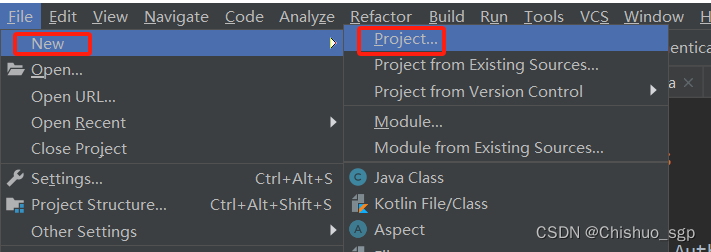
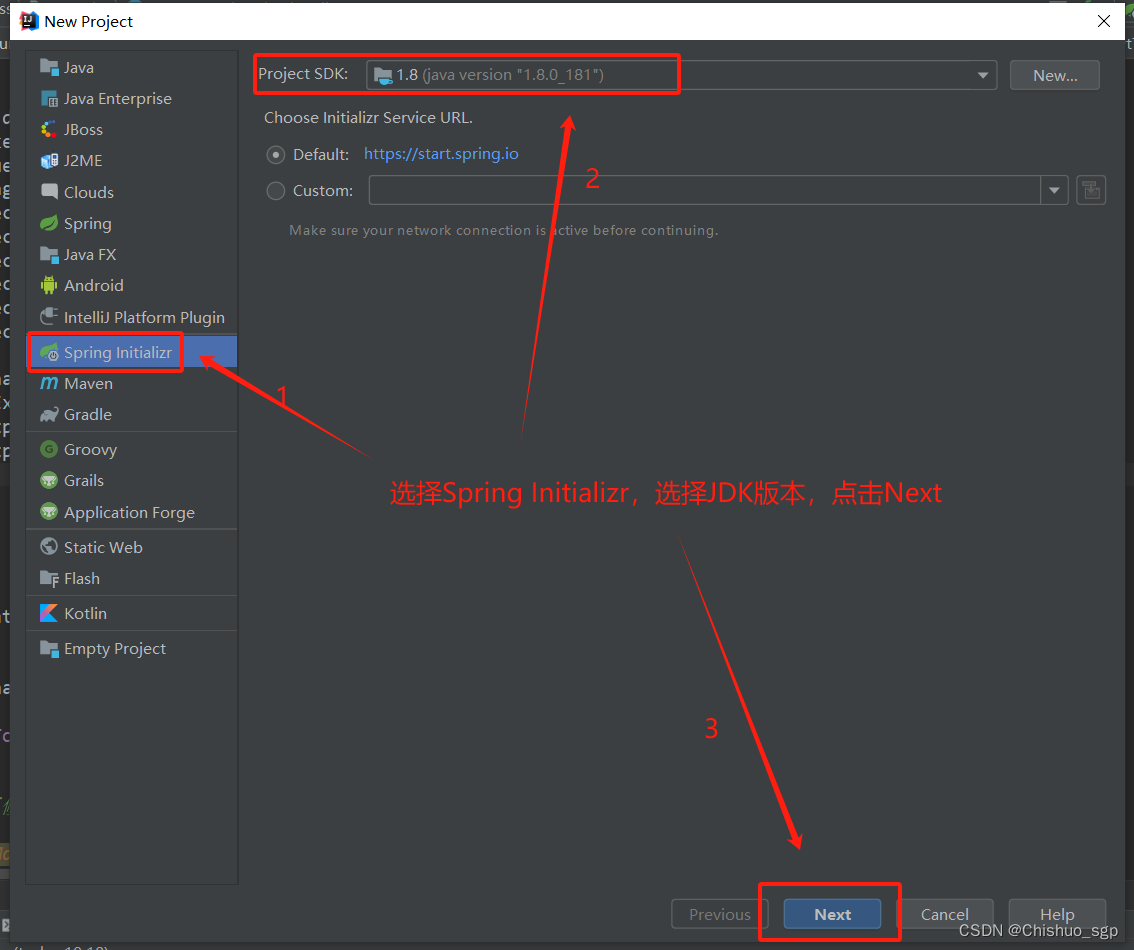
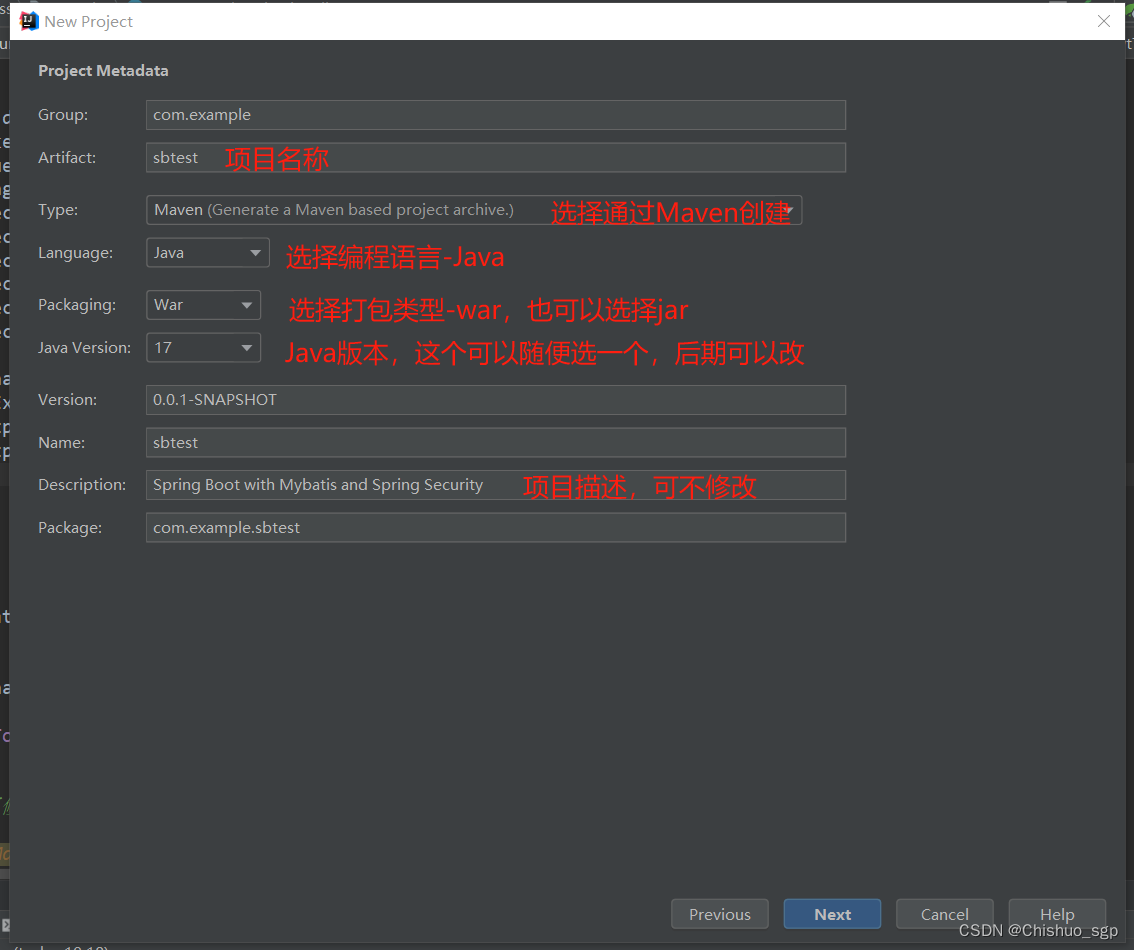
依次在Developer Tools选择Spring Boot DevTools、Lombok
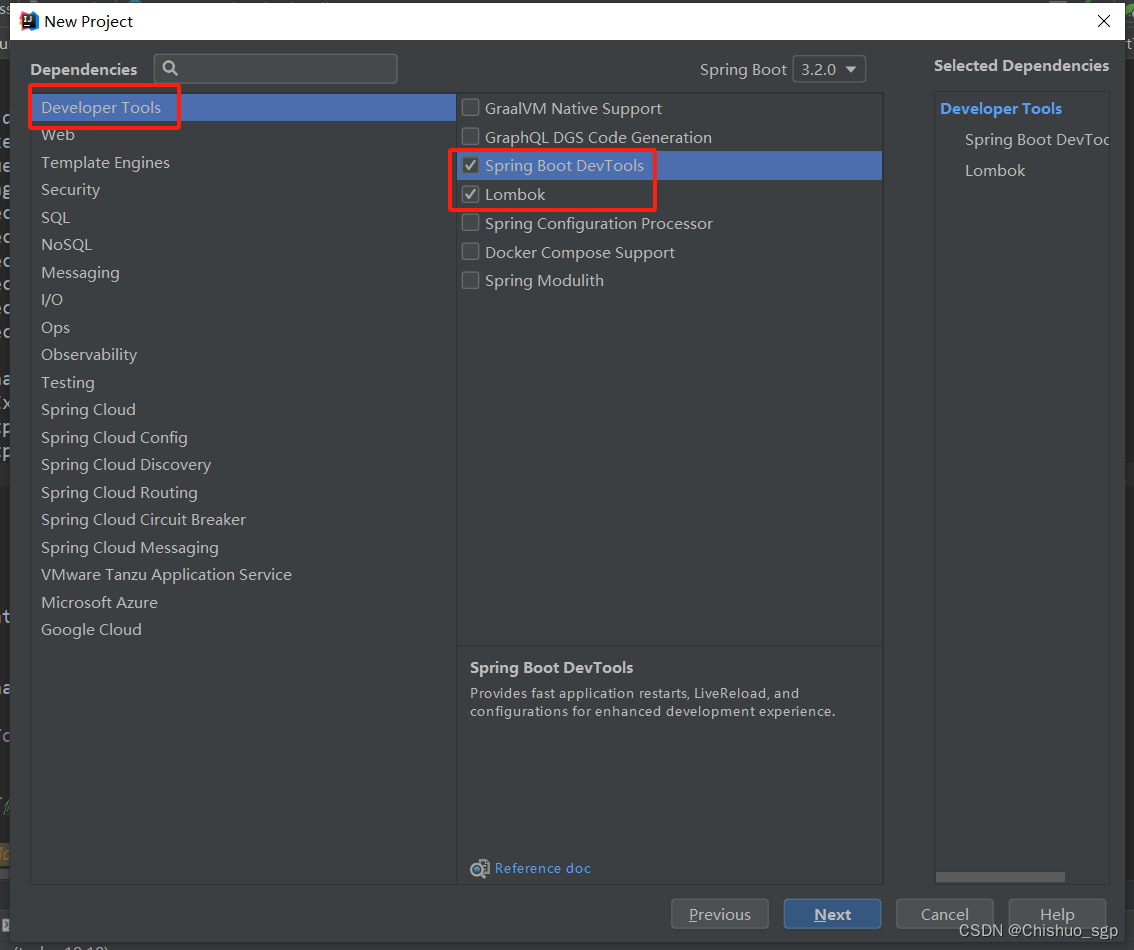
Security选择spring security

在SQL目录下选择MyVatis Framework 和MySQL Driver,右侧可以看到已经选择的框架,上方可以选择spring boot的版本
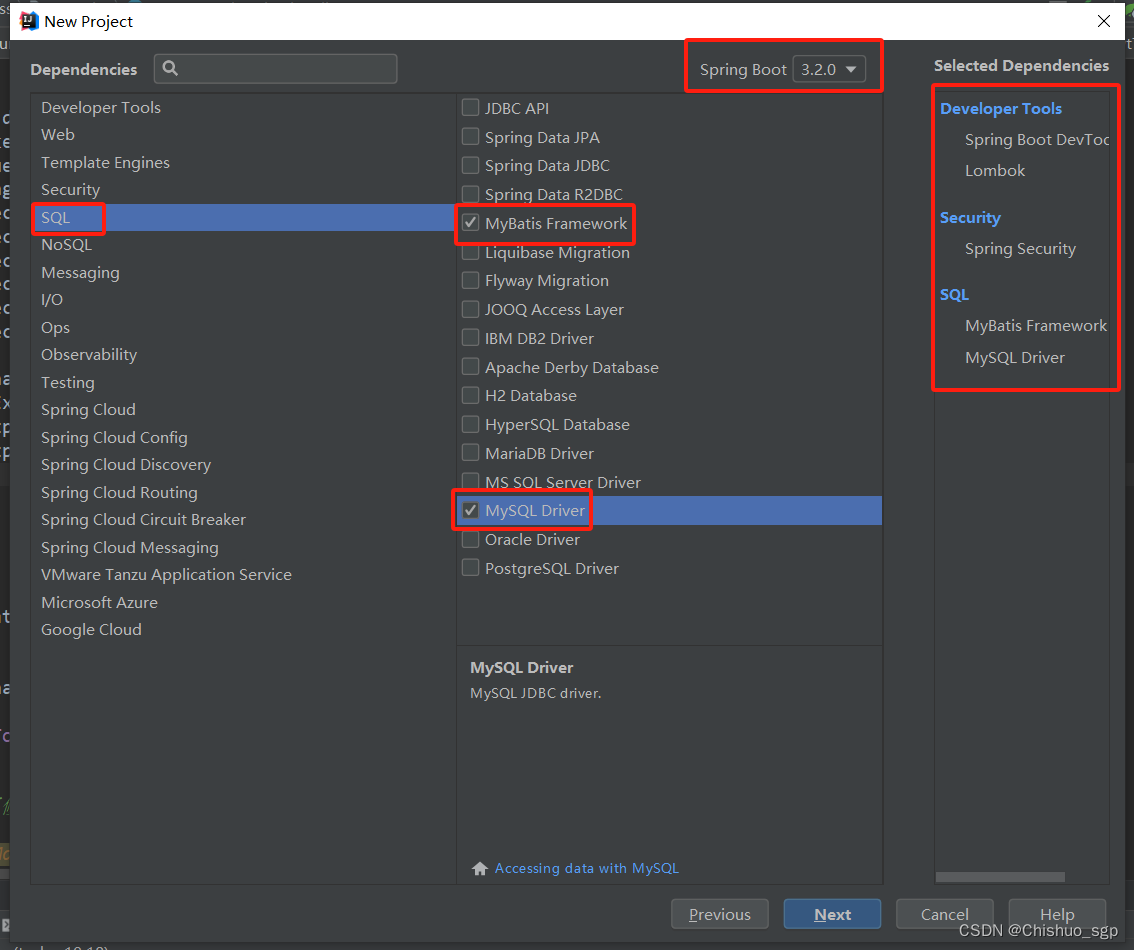
这几项选完以后,spring boot就会自动帮我们加载好这些框架\依赖
因为spring boot的新版本不太熟悉,可以改成比较成熟的2.4.2版本

因为后边的开发中,会继续添加几个相关的依赖,所以后边的内容均以已经完成的完整项目代码为例进行说明
完整的pom文件如下:
<?xml version="1.0" encoding="UTF-8"?>
<project xmlns="http://maven.apache.org/POM/4.0.0" xmlns:xsi="http://www.w3.org/2001/XMLSchema-instance"xsi:schemaLocation="http://maven.apache.org/POM/4.0.0 https://maven.apache.org/xsd/maven-4.0.0.xsd"><modelVersion>4.0.0</modelVersion><parent><groupId>org.springframework.boot</groupId><artifactId>spring-boot-starter-parent</artifactId><version>2.4.2</version><relativePath/> <!-- lookup parent from repository --></parent><groupId>com.sgp</groupId><artifactId>ss</artifactId><version>0.0.1-SNAPSHOT</version><name>ss</name><description>Demo project for Spring Boot</description><properties><java.version>1.8</java.version><mysql-connector-java.version>8.0.17</mysql-connector-java.version></properties><dependencies><dependency><groupId>org.springframework.boot</groupId><artifactId>spring-boot-starter-jdbc</artifactId></dependency><dependency><groupId>org.springframework.boot</groupId><artifactId>spring-boot-starter-security</artifactId></dependency><dependency><groupId>org.springframework.boot</groupId><artifactId>spring-boot-starter-thymeleaf</artifactId></dependency><dependency><groupId>org.springframework.boot</groupId><artifactId>spring-boot-starter-web</artifactId></dependency><dependency><groupId>org.mybatis.spring.boot</groupId><artifactId>mybatis-spring-boot-starter</artifactId><version>2.1.0</version></dependency><!--<dependency>--><!--<groupId>org.thymeleaf.extras</groupId>--><!--<artifactId>thymeleaf-extras-springsecurity6</artifactId>--><!--</dependency>--><dependency><groupId>org.springframework.boot</groupId><artifactId>spring-boot-devtools</artifactId><scope>runtime</scope><optional>true</optional></dependency><dependency><groupId>mysql</groupId><artifactId>mysql-connector-java</artifactId><version>${mysql-connector-java.version}</version></dependency><dependency><groupId>org.projectlombok</groupId><artifactId>lombok</artifactId><optional>true</optional></dependency><dependency><groupId>org.springframework.boot</groupId><artifactId>spring-boot-starter-test</artifactId><scope>test</scope></dependency><!--<dependency>--><!--<groupId>org.mybatis.spring.boot</groupId>--><!--<artifactId>mybatis-spring-boot-starter-test</artifactId>--><!--<version>3.0.3</version>--><!--<scope>test</scope>--><!--</dependency>--><dependency><groupId>org.springframework.security</groupId><artifactId>spring-security-test</artifactId><scope>test</scope></dependency><dependency><groupId>com.auth0</groupId><artifactId>java-jwt</artifactId><version>3.19.2</version></dependency><dependency><groupId>io.jsonwebtoken</groupId><artifactId>jjwt</artifactId><version>0.9.0</version></dependency><dependency><groupId>commons-lang</groupId><artifactId>commons-lang</artifactId><version>2.5</version></dependency><dependency><groupId>org.springframework.data</groupId><artifactId>spring-data-jpa</artifactId><version>2.4.6</version></dependency><dependency><groupId>org.hibernate</groupId><artifactId>hibernate-entitymanager</artifactId><version>4.2.1.Final</version></dependency></dependencies><build><resources><!--<resource>--><!--<directory>src/main/java/com/sgp/ss/mapper</directory>--><!--<targetPath>mapper</targetPath>--><!--</resource>--><!--<resource>--><!--<directory>src/main/resources</directory>--><!--</resource>--><resource><directory>src/main/java</directory><includes><!--<include>**/*.properties</include>--><include>**/*.xml</include></includes><filtering>false</filtering></resource><!--<resource>--><!--<directory>src/main/resources</directory>--><!--<includes>--><!--<include>**/*.properties</include>--><!--<include>**/*.xml</include>--><!--</includes>--><!--<filtering>false</filtering>--><!--</resource>--></resources><plugins><plugin><groupId>org.springframework.boot</groupId><artifactId>spring-boot-maven-plugin</artifactId><configuration><excludes><exclude><groupId>org.projectlombok</groupId><artifactId>lombok</artifactId></exclude></excludes></configuration></plugin></plugins></build></project>
完整配置文件application.properties如下:
spring.mvc.view.prefix=/WEB-INF/jsp/
spring.mvc.view.suffix=.jspserver.port=8080
spring.jackson.serialization.FAIL_ON_EMPTY_BEANS=false
spring.main.allow-bean-definition-overriding=true# Show or not log for each sql query
spring.jpa.database = MYSQL
spring.jpa.show-sql = true
spring.jpa.open-in-view=false# database
spring.datasource.url=jdbc:mysql://localhost:3306/test?useUnicode=true&characterEncoding=UTF-8&useOldAliasMetadataBehavior=true&serverTimezone=UTC
spring.datasource.driver-class-name=com.mysql.cj.jdbc.Driver
spring.datasource.username=root
spring.datasource.password=rootmybatis.mapper-locations = classpath:com/sgp/ss/mapper/*.xml
完整的代码目录如下:
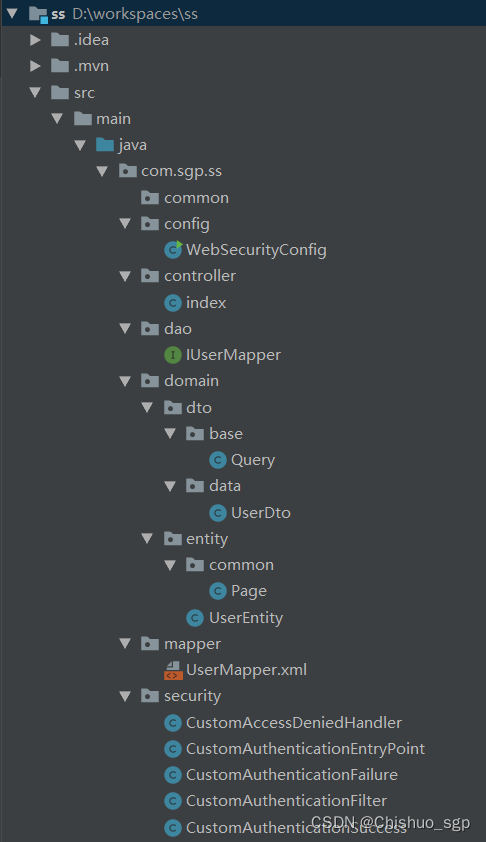
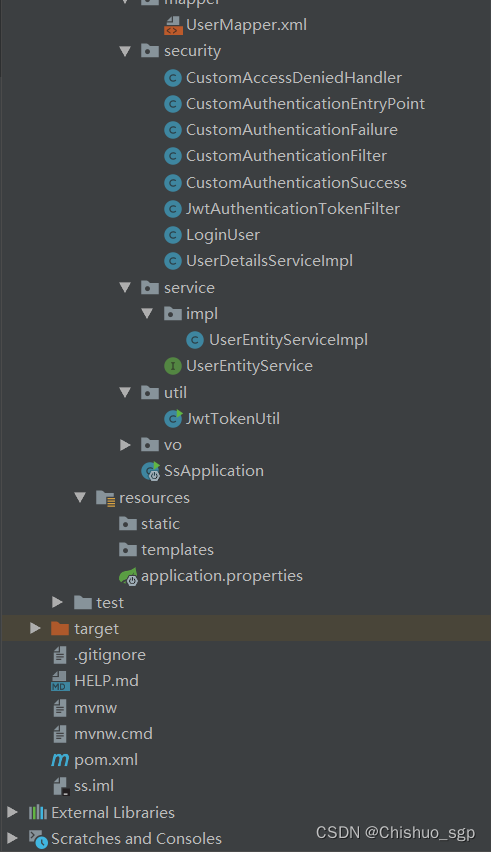
mybatis配置与代码
mybatis主要的配置涉及以下几个地方:
1,pom文件配置
因为在代码目录中,*Mappee.xml文件放在了main/src/java目录下,所以需要在pom文件中配置不要过来/java目录下是xml文件,如果不添加这个配置,那么在target文件包下就没有xml文件,项目就会报Invalid bound statement (not found)的错误,而且一定要注意标签include内的内容,一定要写成**/*xml这个形式,其他形式都不要写
这部分配置可以参考BindingException:Invalid bound statement (not found)异常_bindingexception: invalid bound statement-CSDN博客
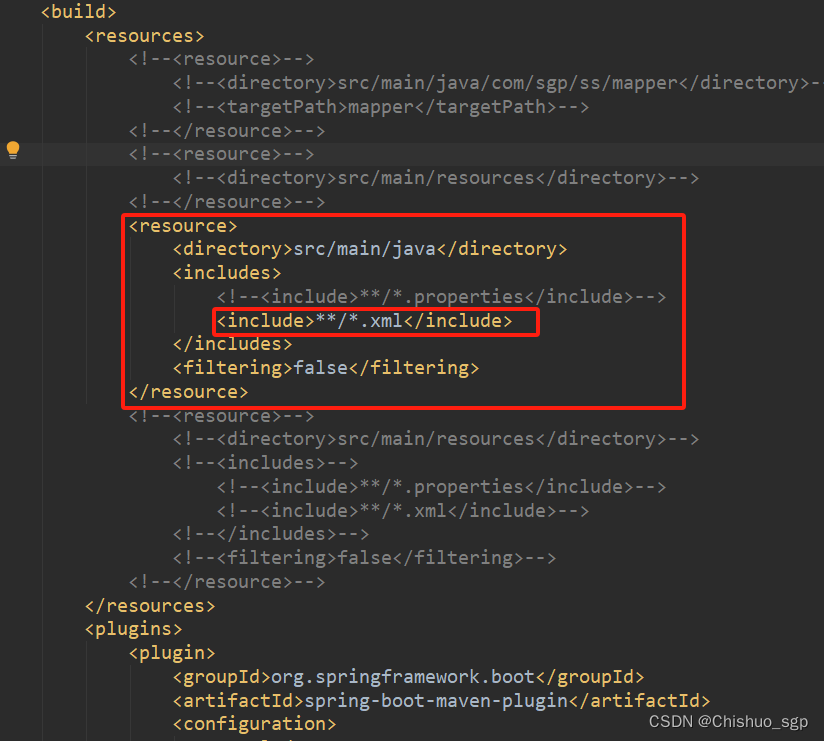
2,application.properties文件配置
配置xml文件的扫描位置,这个需要在配置文件application.properties中配置,建议写完整路径,这样不容易出错,一定要注意,路径中不能出现空格等特殊符号!

3,启动类注解
最后开启项目启动后对mapper文件进行扫描,需要在启动类上添加注解
@MapperScan(basePackages = "com.sgp.ss.dao")
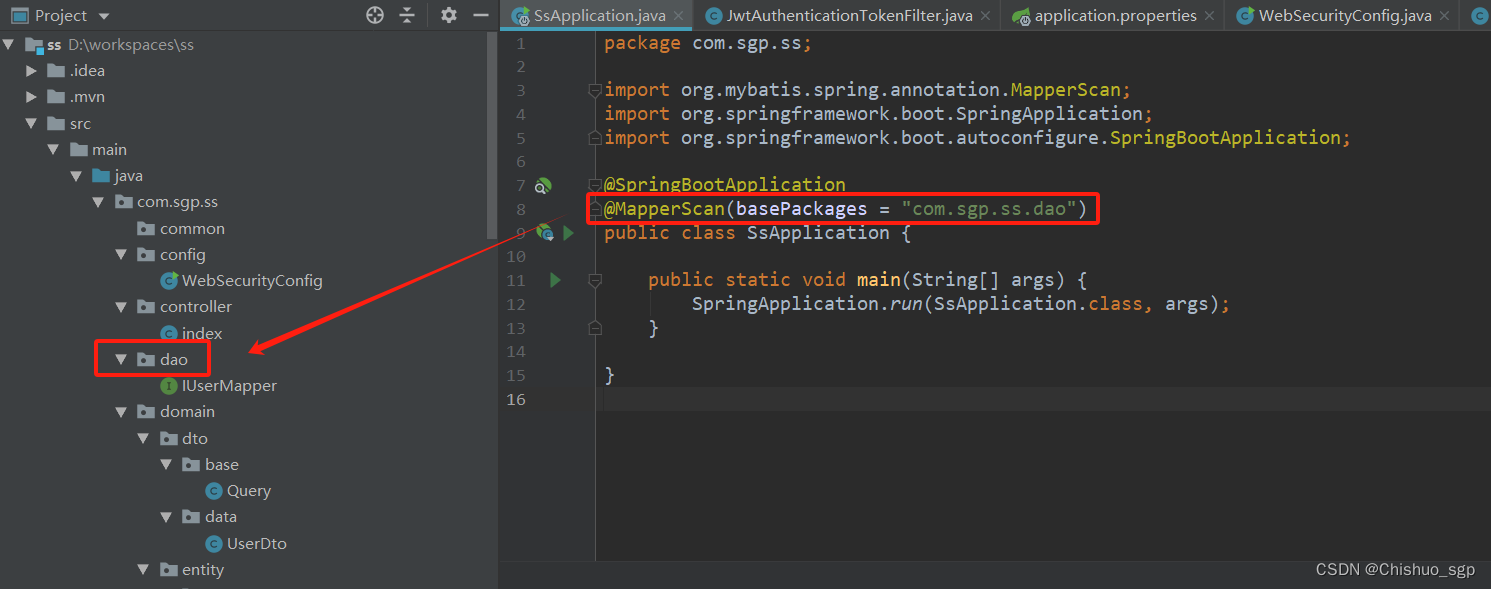
4,相关代码
上述配置完成后,编写数据库表以及相应的dao,dto,entity,service,mapper文件,然后application.properties文件中配置数据库,把所有数据库的相关代码编写完成,比如测试登录验证用的用户信息表,具体如下:
#数据库建表语句 CREATE TABLE `user` ( `id` int(11) NOT NULL AUTO_INCREMENT, `username` varchar(255) DEFAULT NULL, `password` varchar(255) DEFAULT NULL, `permission` varchar(255) DEFAULT NULL, `role` varchar(255) DEFAULT NULL, PRIMARY KEY (`id`) ) ENGINE=InnoDB AUTO_INCREMENT=4 DEFAULT CHARSET=latin1
#entity对象
package com.sgp.ss.domain.entity;/*** @author shanguangpu* @date 2023/2/22 17:33*/
public class UserEntity {private Long id;private String username;private String password;private String permission;private String role;public Long getId() {return id;}public void setId(Long id) {this.id = id;}public String getUsername() {return username;}public void setUsername(String username) {this.username = username;}public String getPassword() {return password;}public void setPassword(String password) {this.password = password;}public String getPermission() {return permission;}public void setPermission(String permission) {this.permission = permission;}public String getRole() {return role;}public void setRole(String role) {this.role = role;}
}
#dto对象
package com.sgp.ss.domain.dto.data;/*** @author shanguangpu* @date 2023/2/22 17:32*/
public class UserDto {private Long id;private String username;private String password;private String permission;private String role;public Long getId() {return id;}public void setId(Long id) {this.id = id;}public String getUsername() {return username;}public void setUsername(String username) {this.username = username;}public String getPassword() {return password;}public void setPassword(String password) {this.password = password;}public String getPermission() {return permission;}public void setPermission(String permission) {this.permission = permission;}public String getRole() {return role;}public void setRole(String role) {this.role = role;}
}
#DAO代码
package com.sgp.ss.dao;import com.sgp.ss.domain.dto.data.UserDto;
import com.sgp.ss.domain.entity.UserEntity;
import org.springframework.stereotype.Repository;import java.util.List;/*** @author shanguangpu* @date 2023/2/22 17:34*/
@Repository
public interface IUserMapper {public void truncate();/*** 新增对象** @param* @return*/public void insert(UserEntity userEntity);/*** 更新对象** @param* @return*/public void update(UserEntity userEntity);/*** 删除记录** @param* @return*/public void delete(Long id);/*** 根据主键获取对象** @param id* 主键字段* @return*/public UserEntity getUserEntityById(Long id);public UserEntity getUserEntityByName(String username);/*** 根据查询Bean获取对象集合,不带翻页** @param queryBean* @return*/public List<UserEntity> queryUserEntityList(UserDto queryBean);}
#service接口文件
package com.sgp.ss.service;import com.sgp.ss.domain.dto.data.UserDto;
import com.sgp.ss.domain.entity.UserEntity;
import org.springframework.stereotype.Component;import java.util.List;/*** @author shanguangpu* @date 2023/2/22 17:49*/
@Component
public interface UserEntityService {public void truncate();/*** 新增对象** @param* @return*/public void insert(UserDto userDto);/*** 更新对象** @param* @return*/public void update(UserDto userDto);/*** 删除记录** @param* @return*/public void delete(Long id);/*** 根据主键获取对象** @param id* 主键字段* @return*/public UserEntity getUserEntityById(Long id);public UserEntity getUserEntityByName(String username);/*** 根据查询Bean获取对象集合,不带翻页** @param queryBean* @return*/public List<UserEntity> queryUserEntityList(UserDto queryBean);}
#service实现类
package com.sgp.ss.service.impl;import com.sgp.ss.dao.IUserMapper;
import com.sgp.ss.domain.dto.data.UserDto;
import com.sgp.ss.domain.entity.UserEntity;
import com.sgp.ss.service.UserEntityService;
//import com.sgp.ss.util.BeanUtils;
import org.apache.commons.logging.Log;
import org.apache.commons.logging.LogFactory;
import org.springframework.beans.factory.annotation.Autowired;
import org.springframework.stereotype.Service;
import org.springframework.transaction.annotation.Transactional;import java.util.List;/*** @author shanguangpu* @date 2023/2/22 17:50*/
@Service
@Transactional
public class UserEntityServiceImpl implements UserEntityService {/** LOG */private static final Log LOG = LogFactory.getLog(UserEntityServiceImpl.class);@Autowiredprivate IUserMapper userMapper;@Overridepublic void truncate() {}@Overridepublic void insert(UserDto userDto) {try {if (null != userDto) {UserEntity entity = new UserEntity();
// BeanUtils.copyProperties(userDto, entity);entity.setId(userDto.getId());entity.setUsername(userDto.getUsername());entity.setPassword(userDto.getPassword());entity.setPermission(userDto.getPermission());entity.setRole(userDto.getRole());userMapper.insert(entity);} else {LOG.warn("UserEntityServiceImpl#insert failed, param is illegal.");}} catch (Exception e) {LOG.warn("UserEntityServiceImpl#insert failed, UserEntity has existed.");throw e;}}@Overridepublic void update(UserDto userDto) {boolean resultFlag = false;try {if (null != userDto) {UserEntity entity = new UserEntity();entity.setId(userDto.getId());entity.setUsername(userDto.getUsername());entity.setPassword(userDto.getPassword());entity.setPermission(userDto.getPermission());entity.setRole(userDto.getRole());userMapper.update(entity);} else {LOG.warn("UserEntityServiceImpl#update failed, param is illegal.");}} catch (Exception e) {LOG.error("UserEntityServiceImpl#update has error.", e);}}@Overridepublic void delete(Long id) {userMapper.delete(id);}@Overridepublic UserEntity getUserEntityById(Long id) {UserEntity userEntity = null;try {if (null != id) {userEntity = userMapper.getUserEntityById(id);} else {LOG.warn("UserEntityServiceImpl#getUserEntityById failed, param is illegal.");}} catch (Exception e) {LOG.error("UserEntityServiceImpl#getUserEntityById has error.", e);}return userEntity;}public UserEntity getUserEntityByName(String username){UserEntity userEntity = null;try {if (null != username) {userEntity = userMapper.getUserEntityByName(username);} else {LOG.warn("UserEntityServiceImpl#getUserEntityByName failed, param is illegal.");}} catch (Exception e) {LOG.error("UserEntityServiceImpl#getUserEntityByName has error.", e);}return userEntity;}@Overridepublic List<UserEntity> queryUserEntityList(UserDto queryBean) {List<UserEntity> userEntities = null;try {userEntities = userMapper.queryUserEntityList(queryBean);} catch (Exception e) {LOG.error("UserEntityServiceImpl#queryUserEntityList has error.", e);}return userEntities;}
}
#mapper.xml文件
<?xml version="1.0" encoding="UTF-8" ?>
<!DOCTYPE mapper PUBLIC "-//mybatis.org//DTD Mapper 3.0//EN" "http://mybatis.org/dtd/mybatis-3-mapper.dtd" ><mapper namespace="com.sgp.ss.dao.IUserMapper"><resultMap id="UserEntityMap" type="com.sgp.ss.domain.entity.UserEntity"><result column="id" property="id" jdbcType="DECIMAL" /><result column="username" property="username" jdbcType="VARCHAR" /><result column="password" property="password" jdbcType="VARCHAR" /><result column="permission" property="permission" jdbcType="VARCHAR" /><result column="role" property="role" jdbcType="VARCHAR" /></resultMap><sql id="UserEntityColumns">id,username,password,permission,role</sql><sql id="UserEntityUsedColumns">username,password,permission,role</sql><!-- 清空表 --><delete id="truncate" parameterType="java.lang.Long">truncate table user</delete><!-- 创建信息 --><insert id="insert" parameterType="com.sgp.ss.domain.entity.UserEntity">INSERT INTO user(<include refid="UserEntityUsedColumns"/>)VALUES (#{username},#{password},#{permission},#{role})</insert><!-- 修改信息 --><update id="update" parameterType="com.sgp.ss.domain.entity.UserEntity"><if test="_parameter != null"><if test="id != null and id > 0">update user set<if test="id != null and id != ''">id = #{id,jdbcType=DECIMAL},</if><if test="username != null and username != ''">username = #{username,jdbcType=VARCHAR},</if><if test="password != null and password != ''">password = #{password,jdbcType=VARCHAR},</if><if test="permission != null and permission != ''">permission = #{permission,jdbcType=VARCHAR},</if><if test="role != null and role != ''">role = #{role,jdbcType=VARCHAR},</if>id = idwhere id = #{id}</if></if></update><!-- 删除信息-逻辑删除 --><delete id="delete" parameterType="java.lang.Long">delete from user where id = #{id}</delete><!-- 根据主键获取对象信息 --><select id="getUserEntityById" resultMap="UserEntityMap" parameterType="java.lang.Long"><if test="_parameter != null">select <include refid="UserEntityColumns"/> from userwhere id = #{_parameter} and 1 = 1</if></select><!-- 根据名称获取对象信息 --><select id="getUserEntityByName" resultMap="UserEntityMap" parameterType="java.lang.Long"><if test="_parameter != null">select <include refid="UserEntityColumns"/> from userwhere username = #{username} and 1 = 1</if></select><!-- 根据查询Bean获取数据集合,不带翻页 --><select id="queryUserEntityList" resultMap="UserEntityMap"parameterType="com.sgp.ss.domain.dto.data.UserDto">select <include refid="UserEntityColumns"/> from user where <include refid="queryUserEntityListWhere"/></select><!-- 常用的查询Where条件 --><sql id="queryUserEntityListWhere">1 = 1<if test="id != null and id != ''">and id = #{id,jdbcType=DECIMAL}</if><if test="username != null and username != ''">and username = #{username,jdbcType=VARCHAR}</if><if test="password != null and password != ''">and password = #{password,jdbcType=VARCHAR}</if><if test="permission != null and permission != ''">and permission = #{permission,jdbcType=VARCHAR}</if><if test="role != null and role != ''">and role = #{role,jdbcType=VARCHAR}</if></sql>
</mapper>mybatis配置完成后,可以编写controller文件进行数据库测试
package com.sgp.ss.controller;import com.sgp.ss.dao.IUserMapper;
import com.sgp.ss.domain.dto.data.UserDto;
import com.sgp.ss.domain.entity.UserEntity;
import com.sgp.ss.security.LoginUser;
import com.sgp.ss.util.JwtTokenUtil;
import org.springframework.beans.factory.annotation.Autowired;
import org.springframework.web.bind.annotation.GetMapping;
import org.springframework.web.bind.annotation.PostMapping;
import org.springframework.web.bind.annotation.RestController;import java.util.List;/*** @author shanguangpu* @date 2023/12/12 14:59*/
@RestController
public class index {@Autowiredprivate IUserMapper userMapper;@GetMapping(value = "hello")public String request(){System.out.println("hello word");return "hello success";}@PostMapping(value = "query")public String selectInfo(){List<UserEntity> userEntities = userMapper.queryUserEntityList(new UserDto());return userEntities.toString();}}
由于已经添加了spring security登录验证功能,所以代码中在没有配置spring security的前提下,数据库的测试会被登录验证拦截,所以可以在配置完成security后一并进行测试
spring security配置与代码
spring security的核心就是过滤器链,框架提供了十几种过滤器,其中比较主要的是认证过滤器和JWT过滤器,另外security对用户信息和用户服务功能进行了规范封装,即接口UserDetails和UserDetailsService,所以如果要自定义过滤器,除了要复写几个过滤器外,还要编写用户信息去实现规范用户接口UserDetails和UserDetailsService
1,UserDetails接口实现
首先编写用户登录信息对象实现UserDetails接口,这里为了区别用于数据库查询的用户类,新建Java类继承已有用户类,并实现UserDetails接口。代码如下
package com.sgp.ss.security;import com.sgp.ss.domain.entity.UserEntity;
import org.springframework.security.core.GrantedAuthority;
import org.springframework.security.core.userdetails.UserDetails;import java.util.Collection;
import java.util.HashSet;
import java.util.Set;/*** @author shanguangpu* @date 2023/11/30 15:58*/
public class LoginUser extends UserEntity implements UserDetails {Collection<? extends GrantedAuthority> authorities;private Set<String> permissions = new HashSet<>();public LoginUser(UserEntity userEntity){if (null != userEntity){this.setUsername(userEntity.getUsername());this.setPassword(userEntity.getPassword());}}public LoginUser(UserEntity userEntity, Collection<? extends GrantedAuthority> authorities){this.setId(userEntity.getId());this.setUsername(userEntity.getUsername());this.setPassword(userEntity.getPassword());permissions.add(userEntity.getPermission());this.authorities = authorities;}@Overridepublic Collection<? extends GrantedAuthority> getAuthorities() {return this.authorities;}/*** 账户是否过期* @return*/@Overridepublic boolean isAccountNonExpired() {return true;}/*** 账户是否被锁定* @return*/@Overridepublic boolean isAccountNonLocked() {return true;}/*** 证书是否过期* @return*/@Overridepublic boolean isCredentialsNonExpired() {return true;}/*** 账户是否有效* @return*/@Overridepublic boolean isEnabled() {return true;}
}
2,UserDetailsService接口实现
然后编写用户服务实现类,实现UserDetailsService接口,这里主要复写loadUserByUsername(String username)这个方法,这个方法就是去数据库查询用户信息,并返回UserDetails对象,代码如下:
package com.sgp.ss.security;import com.sgp.ss.dao.IUserMapper;
import com.sgp.ss.domain.entity.UserEntity;
import org.springframework.beans.factory.annotation.Autowired;
import org.springframework.security.core.userdetails.UserDetails;
import org.springframework.security.core.userdetails.UserDetailsService;
import org.springframework.security.core.userdetails.UsernameNotFoundException;
import org.springframework.stereotype.Component;/*** @author shanguangpu* @date 2023/11/30 15:50*/
@Component
public class UserDetailsServiceImpl implements UserDetailsService {@AutowiredIUserMapper userMapper;@Overridepublic UserDetails loadUserByUsername(String username) throws UsernameNotFoundException {try {UserEntity userEntityByName = userMapper.getUserEntityByName(username);if (userEntityByName == null){throw new UsernameNotFoundException("用户"+username+"不存在");}return new LoginUser(userEntityByName);} catch (Exception e){e.printStackTrace();}return null;}
}
3,过滤器自定义-JWT过滤器
一般登录认证的流程中都会涉及到token,它可以理解为一个标识令牌,用户在第一次登录的时候系统会返回一个令牌token给用户,该用户在下次登录的时候,就不需要携带用户名密码进行请求了,只需要把token带上,系统可以从token中解析出用户信息,对用户进行验证;如果token在有效期内,则系统就会对请求放行,如果过期,则需要重新携带用户名密码进行登录然后再发送请求,并生成新的token返回给用户,所以我们的JWT过滤器主要就是对token进行验证,如果token有效且不为空,则通过token可以获取到用户信息,如果用户信息验证正确,就调用security框架的UsernamePasswordAuthenticationToken方法,生成security框架用户认证信息token,并存放在框架上下文SecurityContextHolder中,以便在下次登录中进行校验,最后过滤器放行,进行下一个过滤器,如果token为空,则直接放行过滤器,进入下一个过滤器生成token返回给用户,代码如下:
package com.sgp.ss.security;import com.sgp.ss.domain.entity.UserEntity;
import com.sgp.ss.service.UserEntityService;
import com.sgp.ss.util.JwtTokenUtil;
import com.sgp.ss.vo.JwtProperties;
import io.jsonwebtoken.ExpiredJwtException;
import org.springframework.beans.factory.annotation.Autowired;
import org.springframework.security.authentication.UsernamePasswordAuthenticationToken;
import org.springframework.security.core.context.SecurityContextHolder;
import org.springframework.stereotype.Component;
import org.springframework.util.StringUtils;
import org.springframework.web.filter.OncePerRequestFilter;import javax.servlet.FilterChain;
import javax.servlet.ServletException;
import javax.servlet.http.HttpServletRequest;
import javax.servlet.http.HttpServletResponse;
import java.io.IOException;/*** @author shanguangpu* @date 2023/12/8 15:29*/
@Component
public class JwtAuthenticationTokenFilter extends OncePerRequestFilter {@Autowiredprivate UserEntityService userEntityService;@Autowiredprivate JwtTokenUtil jwtTokenUtil;// @Autowired
// private JwtProperties jwtProperties;@Overrideprotected void doFilterInternal(HttpServletRequest request, HttpServletResponse response, FilterChain filterChain) throws ServletException, IOException {//获取token信息final String authorization = request.getHeader("token");String name = null;String authToken = null;if (!StringUtils.isEmpty(authorization)) {authToken = authorization.replace("Authorization", "");try {name = jwtTokenUtil.getUsernameFromToken(authToken);} catch (ExpiredJwtException e){e.printStackTrace();}}if (name != null && SecurityContextHolder.getContext().getAuthentication() == null){
// if (jwtTokenUtil.isTokenValid(name, authToken)){UserEntity userEntityByName = userEntityService.getUserEntityByName(name);UsernamePasswordAuthenticationToken authentication = new UsernamePasswordAuthenticationToken(userEntityByName, null, jwtTokenUtil.getAuthorityFromToken(authToken));SecurityContextHolder.getContext().setAuthentication(authentication);
// }}filterChain.doFilter(request, response);}public JwtAuthenticationTokenFilter(){super();}
}
4,过滤器自定义-Authentication认证过滤器
第二个需要复写的过滤器是认证过滤器,这个过滤器的功能就是从输入流中获取用户信息,生成security的token令牌,交给认证管理器AuthenticationManager,
对于登录成功的用户,将生成框架定义的UsernamePasswordAuthenticationToken保存到上下文中,然后调用复写的成功验证方法successfulAuthentication生成token返回给用户,同时也可以复写验证失败的方法,自定义验证失败后的返回信息,代码如下
package com.sgp.ss.security;import com.fasterxml.jackson.databind.ObjectMapper;
import com.sgp.ss.util.JwtTokenUtil;
import com.sgp.ss.vo.AuthRequestVO;
import org.apache.commons.lang.StringUtils;
import org.springframework.security.authentication.AuthenticationManager;
import org.springframework.security.authentication.BadCredentialsException;
import org.springframework.security.authentication.UsernamePasswordAuthenticationToken;
import org.springframework.security.core.Authentication;
import org.springframework.security.core.AuthenticationException;
import org.springframework.security.web.authentication.UsernamePasswordAuthenticationFilter;import javax.servlet.FilterChain;
import javax.servlet.ServletException;
import javax.servlet.http.HttpServletRequest;
import javax.servlet.http.HttpServletResponse;
import java.io.IOException;/*** @author shanguangpu* @date 2023/12/11 14:57*/
public class CustomAuthenticationFilter extends UsernamePasswordAuthenticationFilter {// @Autowiredprivate AuthenticationManager authenticationManager;private JwtTokenUtil jwtTokenUtil;/*** 这个方法的目的仅仅是为了修改一下默认的登录接口,其他参数均是为了通过WebSecurityConfig配置类实现在本方法中自动注入前边private的类* @param tokenUtil* @param authenticationManager* @param url*/public CustomAuthenticationFilter(JwtTokenUtil tokenUtil, AuthenticationManager authenticationManager, String url) {this.jwtTokenUtil = tokenUtil;//传入这个参数的目的,是为了在WebSecurityConfig配置类中将该类注入this.authenticationManager = authenticationManager;//传入这个参数的目的,是为了在WebSecurityConfig配置类中将该类注入super.setFilterProcessesUrl(url);}@Overridepublic Authentication attemptAuthentication(HttpServletRequest request, HttpServletResponse response) throws AuthenticationException {String username = "";String password = "";//从输入流中获取登录信息try {AuthRequestVO requestVO = new ObjectMapper().readValue(request.getInputStream(), AuthRequestVO.class);username = requestVO.getUsername();password = requestVO.getPassword();if (StringUtils.isBlank(password)){throw new BadCredentialsException("Password cannot be null");}} catch (IOException e){e.printStackTrace();}UsernamePasswordAuthenticationToken authRequest = new UsernamePasswordAuthenticationToken(username, password);this.setDetails(request, authRequest);return authenticationManager.authenticate(authRequest);}@Overrideprotected void successfulAuthentication(HttpServletRequest request, HttpServletResponse response, FilterChain filterChain, Authentication authResult) throws IOException, ServletException {LoginUser userDetails = (LoginUser) authResult.getPrincipal();String token = jwtTokenUtil.generateToken(userDetails);response.setHeader("token", token);}@Overrideprotected void unsuccessfulAuthentication(HttpServletRequest request, HttpServletResponse response, AuthenticationException failed) throws IOException {response.getWriter().write("authentication failed");}}
5,WebSecurityConfig配置类
最后就是spring security的配置类,主要配置用户的密码存储编码,http请求的过滤条件,过滤器的顺序等,代码如下:
package com.sgp.ss.config;import com.sgp.ss.security.*;
import com.sgp.ss.util.JwtTokenUtil;
import org.springframework.beans.factory.annotation.Autowired;
import org.springframework.context.annotation.Bean;
import org.springframework.context.annotation.Configuration;
import org.springframework.http.HttpMethod;
import org.springframework.security.authentication.AuthenticationManager;
import org.springframework.security.config.annotation.authentication.builders.AuthenticationManagerBuilder;
import org.springframework.security.config.annotation.web.builders.HttpSecurity;
import org.springframework.security.config.annotation.web.configuration.EnableWebSecurity;
import org.springframework.security.config.annotation.web.configuration.WebSecurityConfigurerAdapter;
import org.springframework.security.config.http.SessionCreationPolicy;
import org.springframework.security.crypto.bcrypt.BCryptPasswordEncoder;
import org.springframework.security.crypto.password.PasswordEncoder;
import org.springframework.security.web.authentication.UsernamePasswordAuthenticationFilter;/*** @author shanguangpu* @date 2023/11/30 15:25*/
@Configuration
@EnableWebSecurity
//@EnableGlobalMethodSecurity(prePostEnabled = true)
//@EnableConfigurationProperties(JwtProperties.class)
public class WebSecurityConfig extends WebSecurityConfigurerAdapter {@Autowiredprivate UserDetailsServiceImpl userDetailsService;@AutowiredJwtAuthenticationTokenFilter jwtAuthenticationTokenFilter;@Autowiredprivate JwtTokenUtil jwtTokenUtil;@Overrideprotected void configure(AuthenticationManagerBuilder auth) throws Exception{auth.userDetailsService(userDetailsService).passwordEncoder(passwordEncoder());}// @Bean@Overrideprotected void configure(HttpSecurity http) throws Exception {http.csrf().disable()//关闭csrf.sessionManagement().sessionCreationPolicy(SessionCreationPolicy.STATELESS)//不通过session获取securityContext.and().authorizeRequests()
// .antMatchers("/").permitAll().antMatchers("/hello").permitAll()
// .antMatchers(HttpMethod.POST).permitAll()
// .antMatchers("/user/login").anonymous()//对于登录接口,允许匿名访问.anyRequest().authenticated();//所有请求都要经过鉴权认证http.exceptionHandling().authenticationEntryPoint(new CustomAuthenticationEntryPoint()).accessDeniedHandler(new CustomAccessDeniedHandler());//把token校验过滤器添加到过滤器链中http.addFilter(new CustomAuthenticationFilter(jwtTokenUtil, authenticationManager(), "/user/login"));http.addFilterBefore(jwtAuthenticationTokenFilter, CustomAuthenticationFilter.class);http.cors();}@Bean@Overridepublic AuthenticationManager authenticationManagerBean() throws Exception {return super.authenticationManagerBean();}@Beanpublic static PasswordEncoder passwordEncoder(){return new BCryptPasswordEncoder();}public static void main(String[] args) {String encode = passwordEncoder().encode("4321");System.out.println(encode);}}
上述配置中,还有两个认证失败和权限失败两个处理异常类,代码如下:
package com.sgp.ss.security;import org.springframework.security.core.AuthenticationException;
import org.springframework.security.web.AuthenticationEntryPoint;import javax.servlet.RequestDispatcher;
import javax.servlet.ServletException;
import javax.servlet.http.HttpServletRequest;
import javax.servlet.http.HttpServletResponse;
import java.io.IOException;/*** @author shanguangpu* @date 2023/12/8 16:00*/
public class CustomAuthenticationEntryPoint implements AuthenticationEntryPoint {@Overridepublic void commence(HttpServletRequest request, HttpServletResponse response, AuthenticationException authException) throws IOException, ServletException {Throwable t = (Throwable)request.getAttribute(RequestDispatcher.ERROR_EXCEPTION);response.setContentType("application/json;charset=utf-8");response.getWriter().write("{\"code\":\"403\",\"message\":\"请重新登录\"}");}
}
package com.sgp.ss.security;import org.springframework.security.access.AccessDeniedException;
import org.springframework.security.web.access.AccessDeniedHandler;import javax.servlet.ServletException;
import javax.servlet.http.HttpServletRequest;
import javax.servlet.http.HttpServletResponse;
import java.io.IOException;
import java.io.PrintWriter;/*** @author shanguangpu* @date 2023/12/8 15:59*/
public class CustomAccessDeniedHandler implements AccessDeniedHandler {@Overridepublic void handle(HttpServletRequest request, HttpServletResponse response, AccessDeniedException accessDeniedException) throws IOException, ServletException {response.setContentType("application/json;charset=utf-8");PrintWriter out = response.getWriter();out.write("{\"code\":\"403\",\"message\":\"权限不足\"}");out.flush();out.close();}
}
6,JWT工具类
package com.sgp.ss.util;import com.auth0.jwt.JWT;
import com.auth0.jwt.JWTVerifier;
import com.auth0.jwt.algorithms.Algorithm;
import com.auth0.jwt.interfaces.DecodedJWT;
import com.sgp.ss.security.LoginUser;
import com.sgp.ss.vo.JwtProperties;
import io.jsonwebtoken.*;
import io.jsonwebtoken.impl.DefaultClock;
import org.springframework.beans.factory.annotation.Autowired;
import org.springframework.security.core.GrantedAuthority;
import org.springframework.stereotype.Component;
import org.springframework.util.StringUtils;import java.io.Serializable;
import java.util.*;
import java.util.concurrent.ConcurrentHashMap;/*** @author shanguangpu* @date 2023/2/22 10:42*/
@Component
public class JwtTokenUtil implements Serializable {private static final long serialVersionUID = -1264536648286114018L;private Clock clock = DefaultClock.INSTANCE;private Map<String, String> tokenMap = new ConcurrentHashMap<>(32);public String generateToken(LoginUser loginUser){Map<String, Object> claims = new HashMap<>();claims.put("username", loginUser.getUsername());claims.put("authority", loginUser.getAuthorities());String token = generateToken(claims, loginUser.getId() + "");if (! StringUtils.isEmpty(token)){}return token;}/*** 生成token* @param claims* @param subject* @return*/private String generateToken(Map<String, Object> claims, String subject) {final Date createdDate = clock.now();final Date expirationDate = generateExpirationDate(createdDate);return Jwts.builder()// 自定义属性.setClaims(claims).setSubject(subject)// 创建时间.setIssuedAt(createdDate)// 过期时间.setExpiration(expirationDate)// 签名算法及秘钥.signWith(SignatureAlgorithm.HS512, "sgpsgp").compact();}private Date generateExpirationDate(Date createdDate) {return new Date(createdDate.getTime() + 21600 * 1000);}// 从得到的令牌里面获取用户IDpublic Integer getUserIdFromToken(String token) {Integer id = null;try {final Claims claims = getClaimsFromToken(token);id = Integer.parseInt(claims.getSubject());return id;} catch (Exception e) {}return id;}// 从得到的令牌里面获取用户名public String getUsernameFromToken(String token) {String username;try {final Claims claims = getClaimsFromToken(token);username = (String) claims.get("username");} catch (Exception e) {username = null;}return username;}// 从得到的令牌里面获取权限public List<GrantedAuthority> getAuthorityFromToken(String token) {List<GrantedAuthority> list = null;try {final Claims claims = getClaimsFromToken(token);list = (List<GrantedAuthority>)claims.get("authority");return list;} catch (Exception e) {}return list;}// 从得到的令牌里面获取创建时间public Date getCreatedDateFromToken(String token) {Date created;try {final Claims claims = getClaimsFromToken(token);created = claims.getIssuedAt();} catch (Exception e) {created = null;}return created;}// 从得到的令牌里面获取过期时间public Date getExpirationDateFromToken(String token) {Date expiration;try {final Claims claims = getClaimsFromToken(token);expiration = claims.getExpiration();} catch (Exception e) {expiration = null;}return expiration;}private Claims getClaimsFromToken(String token) {Claims claims;try {claims = Jwts.parser().setSigningKey("sgpsgp").parseClaimsJws(token).getBody();} catch (Exception e) {claims = null;}return claims;}/*** 检查token是否过期* @param token* @return*/public Boolean isTokenExpired(String token) {final Date expiration = getExpirationDateFromToken(token);boolean flag = expiration.before(new Date());if(flag) {String username = getUsernameFromToken(token);if(username != null) {tokenMap.remove(username);}}return flag;}public Boolean isTokenValid(String username, String token) {if(tokenMap.get(username) != null && tokenMap.get(username).equals(token.trim())) {return !isTokenExpired(token);}return false;}public Boolean isTokenValid(int id, String token) {if (tokenMap.get(id) != null && tokenMap.get(id).equals(token.trim())) {return !isTokenExpired(token);}return false;}public void deleteToken(String token) {String username = getUsernameFromToken(token);if(username != null) {tokenMap.remove(username);}}public static void main(String[] args) {HashMap<String, Object> map = new HashMap<>();Calendar calendar = Calendar.getInstance();calendar.add(Calendar.SECOND, 60);String token = JWT.create().withHeader(map).withClaim("userName", "aaa").withClaim("password", "1234").withExpiresAt(calendar.getTime()).sign(Algorithm.HMAC256("abcd"));System.out.println(token);JWTVerifier jwtVerifier = JWT.require(Algorithm.HMAC256("abcd")).build();DecodedJWT verify = jwtVerifier.verify(token);System.out.println(verify.getClaim("userName").asString());System.out.println(verify.getClaim("password").asString());}}
postman测试
所有代码编写完成后,可以通过postman进行测试
1,不走登录验证的接口测试
首先验证配置类WebSecurityConfig中放行的/hello地址,这个地址访问的时候不会经过框架验证,直接会得到相应
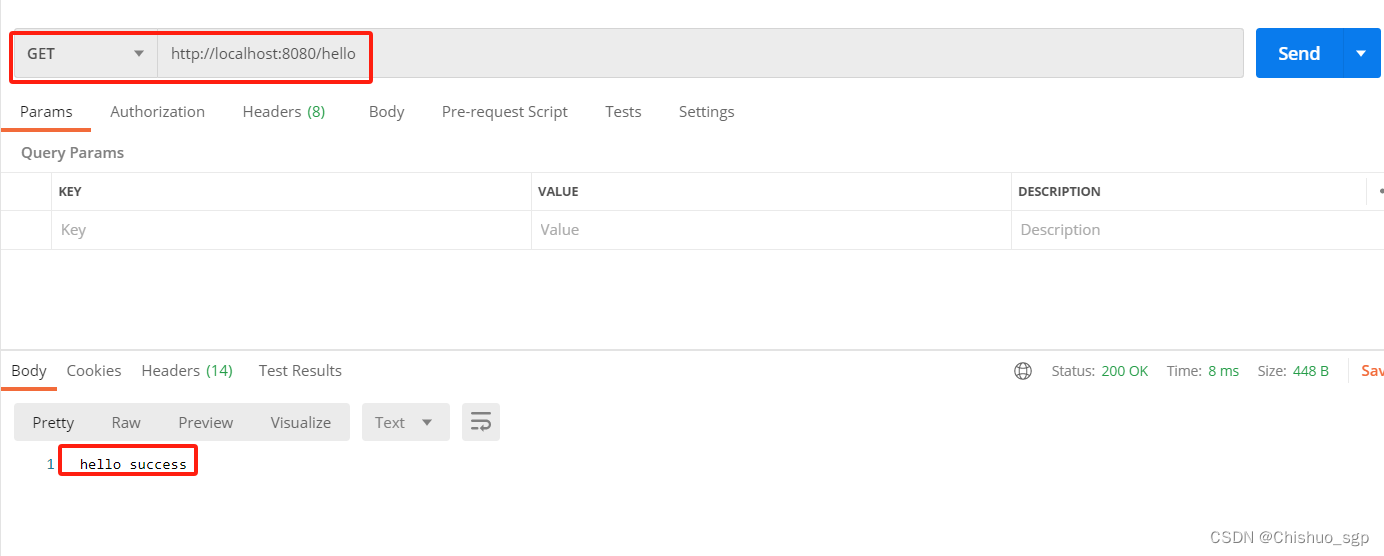
2,登陆页面返回token测试
然后验证登录页面,使用用户名密码首次登录,会返回token,这个用户名密码需要提前在数据库里创建,为了安全起见,用户密码采用加密的密文存储,加密算法就是代码中配置的BCryptPasswordEncoder()方法,这个可以通过一个简单的Java函数得到,具体如下:
public static PasswordEncoder passwordEncoder(){return new BCryptPasswordEncoder();
}public static void main(String[] args) {String encode = passwordEncoder().encode("4321");System.out.println(encode);
}在数据库里存的样式就是下图的样子

在使用postman进行测似的时候,请求体里的用户密码使用明文即可,因为我们在配置类WebSecurityConfig中配置了默认登录地址为/user/login,所以访问这个地址就会返回token,这里注意,登录需要使用POST请求

因为我们没有编写登录成功后的页面,所以响应的body是空的,但是响应头里会看到系统生成的token返回给了用户
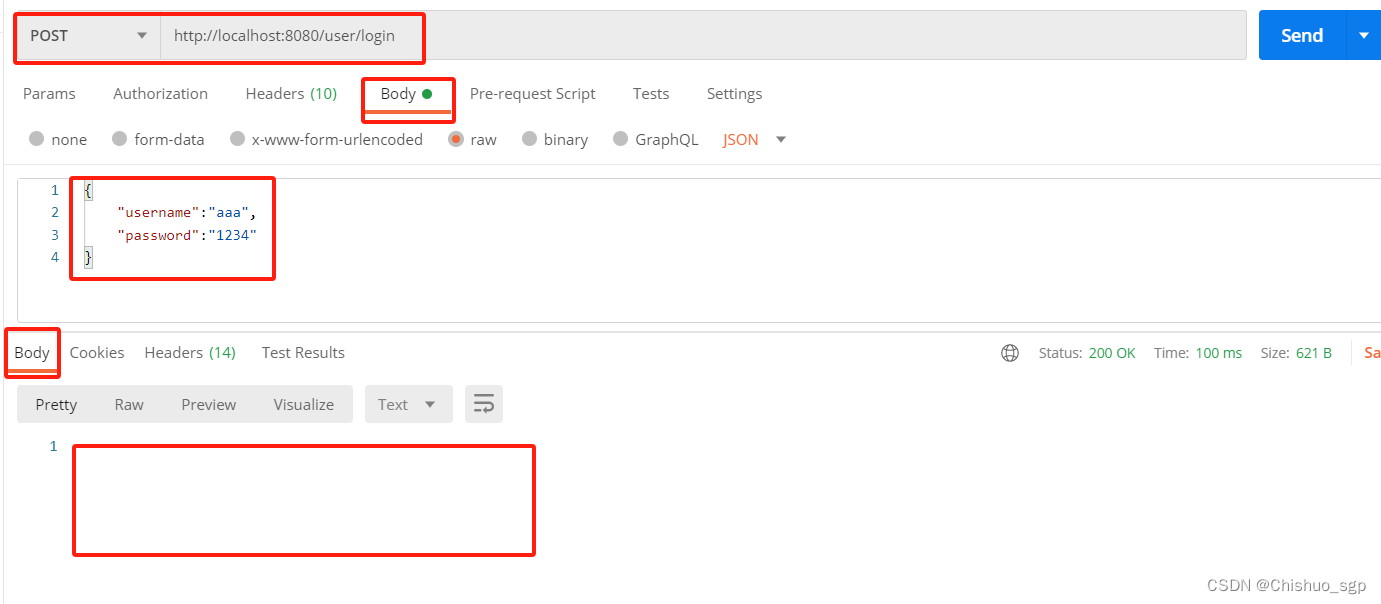
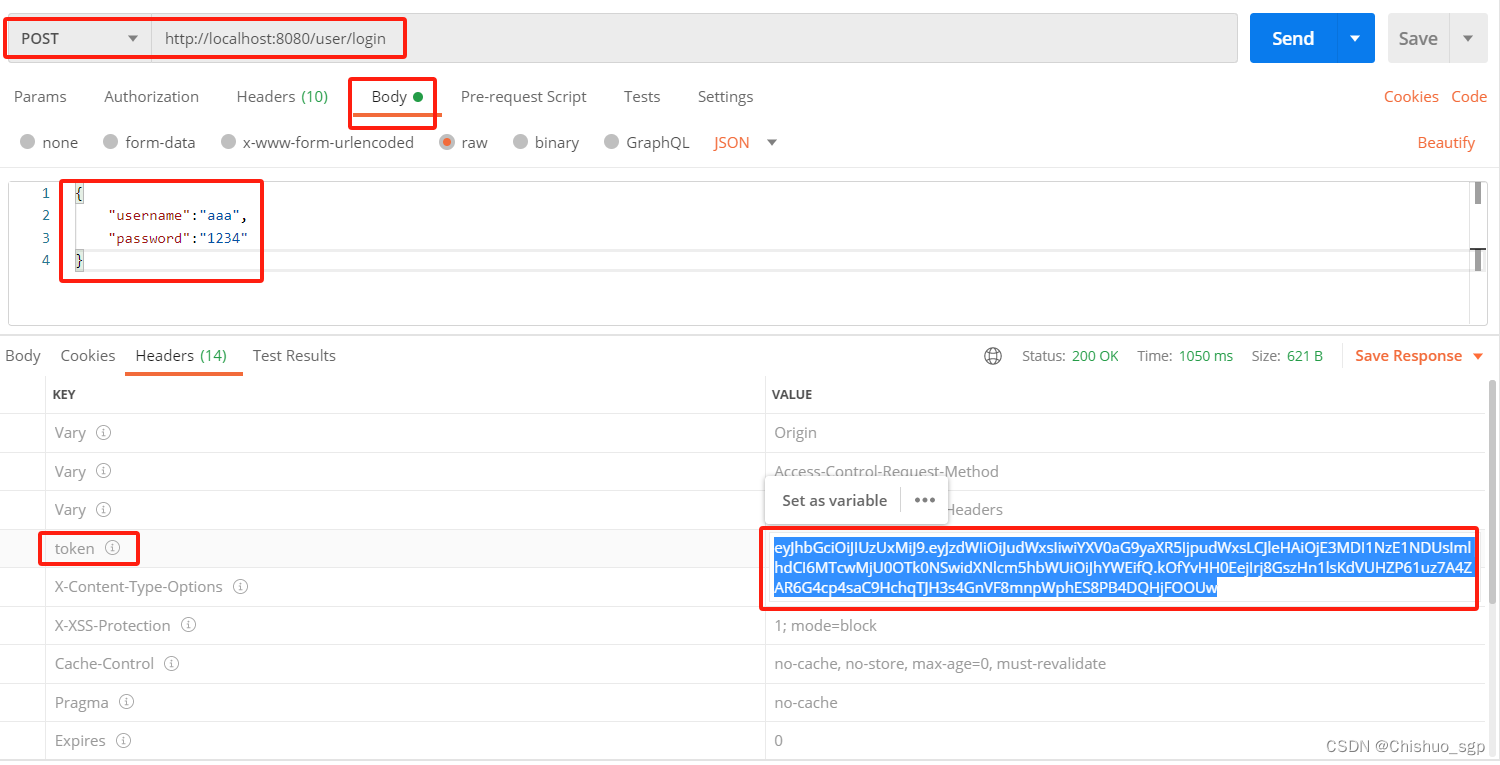
3,携带token请求测试
下一步我们验证数据库的查询接口,也就是index.java中的第二个接口,同时也验证我们的mybatis是否集成成功,这时候需要注意的是,我们需要携带着用户生成的token去访问,否则就会验证失败
首先验证不携带token的情况,,请求头里的token没有打勾,可以看到会直接调用我们之前复写的认证不成功的返回信息

然后我们给请求头里的token打勾,再次发送,可以看到得到了正确的响应内容
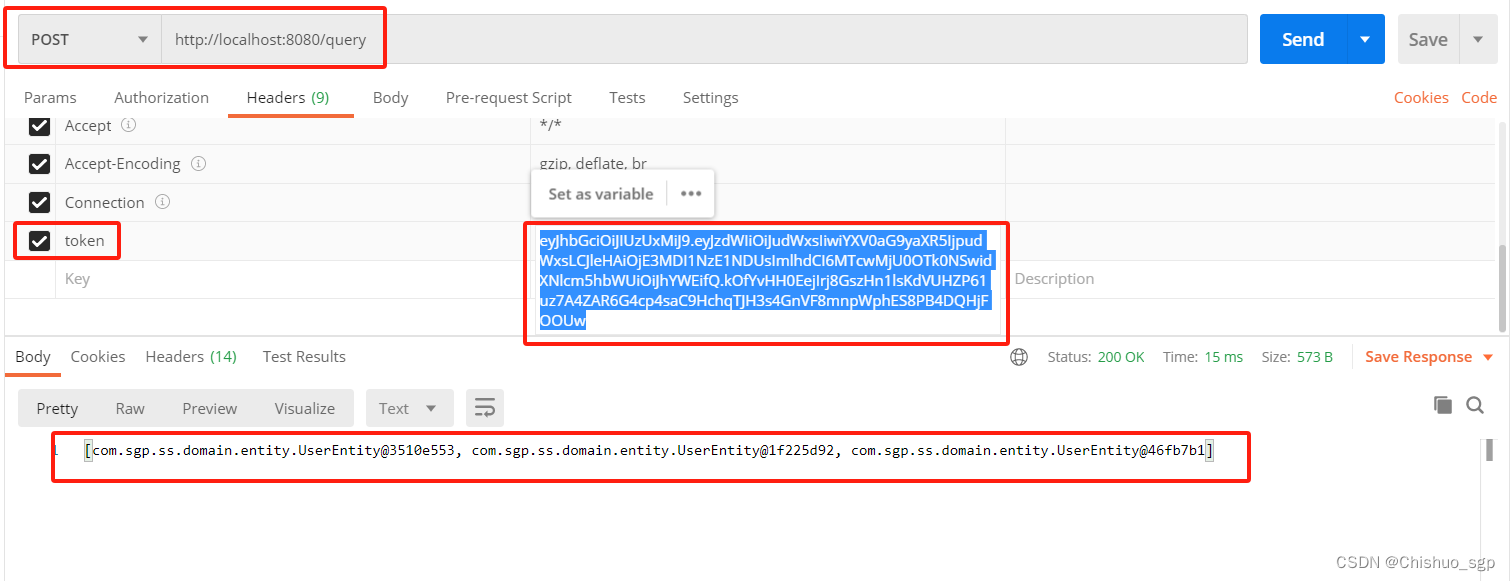
至此,所有功能测试完毕

 -Spring中FactoryBean)
(笔记))



:排序(3)插入排序)
)





)





